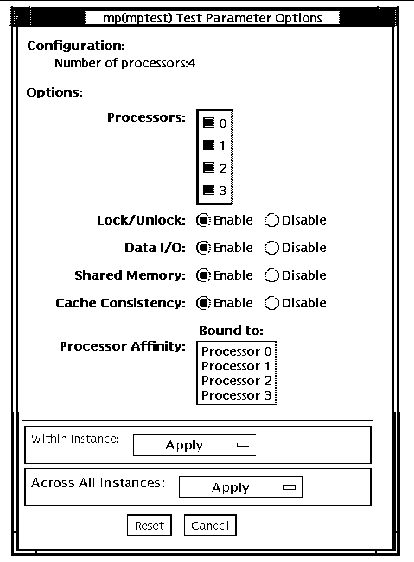Multiprocessor Test (mptest)
|
mptest verifies the functionality of multiprocessing hardware. This test allocates a page of virtual memory for the test--declaring the page shared--locks the page against swapping, and creates threads to each of the processors being tested. Up to 1024 processors can be tested by mptest in a CPU.
The processor mask argument can used during test probing. The mptest verifies that the current processor mask matches the argument you entered in the command line or from the GUI/TTYUI.
mptest Options
To reach the dialog box below, right-click on the test name in the System Map and select Test Parameter Options. If you do not see this test in the System Map, you might need to expand the collapsed groups, or your system may not include the device appropriate to this test. Refer to the SunVTS User's Guide for more details.
FIGURE 38-1 mptest Test Parameter Options Dialog Box

The processors that can be tested are listed in the Configuration area of the menu. You can enable or disable the multiprocessing test for individual processors on this menu.
The options listed in TABLE 38-1 can be run alone or concurrently with other options.
TABLE 38-1 mptest Options
|
mptest Options
|
Description
|
|
Processors
|
You can test specific processors by clicking Select on the check boxes to enable or disable each processor. A check mark means the processor is enabled for testing. The default setting is all processors enabled.
Note: mptest requires at least two enabled processors to test multiprocessing systems.
|
|
Lock/Unlock
|
Tests the lock/unlock mechanism that guarantees exclusive access to a physical page to one processor. A thread is created at each of the processors. Each processor uses the SPARC atomic instruction ldstub to write to the same shared physical memory page. While one processor is attempting the write, the other processors should be free spinning for their turn. As each processor acquires the lock, it writes an ordinal number to a shared trace buffer using a shared write pointer. After the test cycle is complete, the trace buffer is dumped for analysis.
This test fails and returns an error message if the trace buffer does not contain an equal number of ordinal numbers for each processor. For example, if the specified loop count is 5, the trace buffer should contain five 0s, five negative 1s, five 2s, and so on.
|
|
Data I/O
|
Requires two or more threads, each of which locks onto one of the processors. Each processor, in turn, writes data to a temporary file that has been mapped to the physical address. The modified data is immediately read by other processors being tested. This test hangs and fails if the processors do not recognize the expected data.
|
|
Shared Memory
|
A shared memory buffer is divided into a number of contiguous chunks, one for each of the CPUs participating in the test. Each CPU is assigned a unique chunk based upon its ID (1-N). This subtest has two parts.
First, each CPU locks and writes data to its data chunk. Identical data is written for each CPU. Then each CPU reads and compares the information on its data chunk with that of another CPU.
If two CPUs do not confirm consistent data, the test fails and returns an error message. If that happens, testing stops and this test is run again in verbose mode to return more detailed information.
|
|
Cache Consistency
|
Requires two or more processors to access and write to the same physical address. This test verifies that a change in physical address by one processor is confirmed by another.
If two processors do not confirm consistent data, the test continues to run, but the Pass Count in the SunVTS status window stops incrementing. If this happens, stop testing and run the test again in verbose mode for a more detailed picture of the problem.
|
mptest Test Modes
TABLE 38-2 mptest Supported Test Modes
|
Test Mode
|
Description
|
|
Connection
|
Checks the current processors on the system with the original processor mask. An error is reported if the two values do not match. The original processor mask is set during probing, which shows the processors on system during the probe. The status of each selected processor is checked by procsesor_bind.
|
|
Functional
(Offline)
|
This test mode verifies that the current processor mask is the same as that from the command line, or the same as that from the GUI/TTYUI.
|
mptest Command-Line Syntax
/opt/SUNWvts/bin/mptest standard_arguments
-o M=0+1+2+3...,NL,ND,NS,NC,omask=hexidecimal_number
TABLE 38-3 mptest Command-Line Syntax
|
Arguments Description
|
|
M=0+1+2+3...
|
Use 0, 1, 2 to specify the processors to test.
|
|
NL
|
Disables the Lock/Unlock subtest.
|
|
ND
|
Disables the Data I/O subtest.
|
|
NS
|
Disables the Shared Memory subtest.
|
|
NC
|
Disables the Cache Consistency subtest.
|
|
omask=hexidecimal_number
|
Original mask of processors. Bit 0 represents processor 0 and bit 1 represents processor 1. For example, 03333320.
|
|
Note - 64-bit tests are located in the sparcv9 subdirectory: /opt/SUNWvts/bin/sparcv9/testname. If a test is not present in this directory, then it may only be available as a 32-bit test. For more information refer to 32-Bit and 64-Bit Tests.
|
| SunVTS 5.1 Test Reference Manual
| 816-5145-10
|    
|
Copyright © 2002, Sun Microsystems, Inc. All rights reserved.
